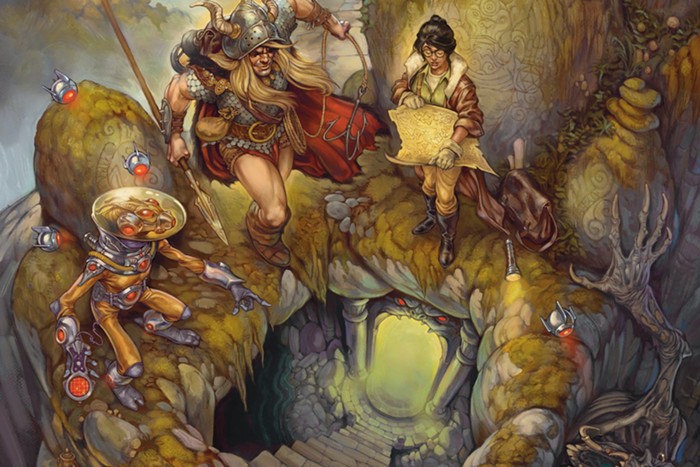by Mark Z. Danielewski
(Pantheon) $20
Aren't you sick of big boy books? The next Pynchon/Vollmann/Wallace crashes the shelves, and by virtue of sheer size and intellectual audacity, the damn thing threatens the willfully ignorant with its mere existence. If their surface complexity remained superficial, these books would be easy to dismiss; unfortunately, the complexity runs deep. In House of Leaves, all those flashy diversions are there for reasons you might get to understand once you submit to the author's scheme.
At the core of Leaves are Pulitzer Prize-winning photographer Navidson and his ex-model girlfriend who move with their kids into a house of horrific proportions. Simple measurement glitches lead to infinite interior chasms that operate at the will of some sinister inner universe. Assisted and later alone, Navidson explores the interior, and according to the next layer of narration, makes The Navidson Record, a "famous" documentary of these adventures.
This layer of narration is then documented by an old blind man named Zampanò in a rambling manuscript that supplies essays, notes, and commentary from real and apocryphal sources. When Zampanò dies, a young hedonistic wastrel named Johnny Truant stumbles into the project and becomes, supposedly, the manuscript's editor and, thanks to long and often irritating footnotes, its co-author.
The risk Danielewski takes here is that the core story told by the documentary of the house is itself a fascinating exploration of the nature of space as it's defined by Renaissance painting (or architectural perspective) and the physical universe, told with a brilliant range of references to art, science, philosophy, and semiotics; but the overarching and ultimately main story is about some jerk who is a Frankenstein's monster of self-involvement jolted to "life" by big-boy-book clichés (lust! quest! obsession!). But it's a mistake to pigeonhole House in that sort of footnote-novel tradition. From Derrida to Paglia, Einstein to Leonard Maltin, the footnotes celebrate wild and often irresponsible connections to the outside world as they delve into a quintessentially hermetic environment.
For that matter, I hesitate now to tack House on to the tradition of big boy books, not for lack of complexity, but happily, for lack of size. Like the Navidson house itself, the Danielewski House expands and contracts, with many pages that are packed with information while many other pages contain a single image or word. Pantheon displays a heroic integrity to follow the author's practical and effective (if unorthodox) formatting directions. The publisher graciously calls this the "second printing" of a work that first appeared in a different form (and size) on the Net. To cut costs, they might have squeezed House into about 400 pages without cutting a word--but that wouldn't have been the whole story. DOUG NUFER
SALAMANDER
by J. Robert Janes
(Soho Press) $22
What happens to "normal" crime during wartime? It continues; so it must be investigated. In occupied France, this calls for the difficult partnership between Jean-Louis St-Cyr of the Sêreté Nationale and Gestapo agent Hermann Kohler. These two detectives are together likeably irascible, and traverse the morally ambiguous terrain in the breach between Nazis, the French resistance, and "normal" criminals. Janes couches their police investigations in the everyday minutiae that only diligent historical research provides--the fabric of ladies' dresses, period menus, architectural details, and so on. Janes can take it for granted that his setup will intrigue and entertain. Laudable and good. But the rest is quite evil.
Why must Janes choose for his characters to be a bunch of creeps who burn their own and their lovers' genitals? And one is an arsonist (surprise!) slaying a movie theater full of people. This classical symmetry, between private pleasure and public cruelty, could be interesting if Janes did any work at all to flesh out the characters' motivation, to make the crime's solution depend on an understanding of the affliction. Unfortunately, Janes' theoretical imagination does not go beyond some lurid details of childhood molestation and a corrupt priest. The solution is revealed by process of elimination instead of probing any psychological depth. Besides the charming two detectives, the other characters seem lifeless and unmotivated in their cruelty, aimless except for their tactical positioning in the geometry of the plot. Whatever link might exist between arson and Eros is so much wallpapering down the mazy corridors to a tidy resolution. Janes wants to titillate or sicken, but he doesn't understand of what he speaks. Janes produces a stable genre piece, but it could be so much more. GREGG MILLER


















